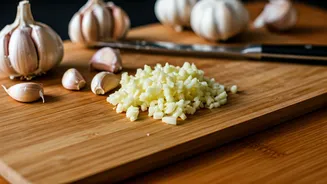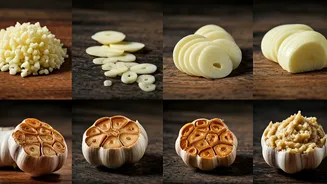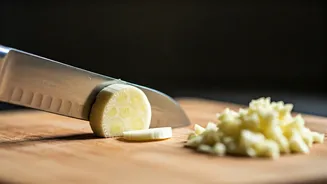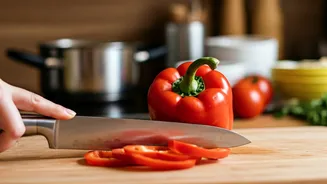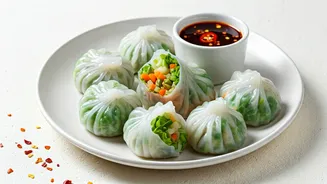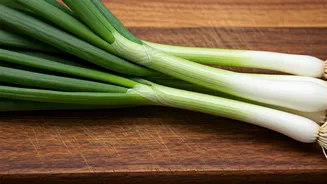Mincing for Flavor
Mincing garlic involves chopping it into very small, irregular pieces. This method is excellent for releasing garlic's intense flavor quickly. The small pieces ensure
maximum surface area exposure, resulting in a robust, pungent taste. Mincing works well in recipes where garlic needs to infuse flavor rapidly, such as sauces, dressings, and stir-fries. To mince garlic, first peel the cloves and remove any root ends. Then, use a chef's knife to chop the garlic repeatedly, gradually reducing the size of the pieces. You can also use a garlic press for a similar effect, though some cooks believe pressing alters the flavor profile, making it more bitter. Mincing is a go-to technique when you want garlic's flavor to be front and center, quickly infusing into the dish.
Dicing for Uniformity
Dicing garlic involves cutting it into small, evenly sized cubes. This technique provides a more uniform texture and flavor distribution throughout a dish. Diced garlic is visually appealing and cooks more evenly than minced garlic, which is essential for certain recipes. It works perfectly in dishes where you want a consistent garlic presence without overpowering other flavors. To dice garlic, peel the cloves and slice them lengthwise into thin planks. Then, rotate the planks and slice them crosswise to create small cubes. The goal is to make all pieces roughly the same size. Dicing is the right choice for dishes where both aesthetics and even flavor are priorities, such as in sautéed vegetables, pasta sauces, and some roasted dishes. The uniform size ensures garlic cooks consistently alongside other ingredients.
Slicing for Elegance
Slicing garlic creates thin, flat pieces, adding visual appeal and a milder garlic flavor compared to mincing or dicing. Sliced garlic lends itself well to dishes where you want to highlight garlic’s presence without overwhelming the other ingredients. Slicing provides a delicate flavor and a slight textural contrast. This technique is often seen in Asian cuisines for stir-fries, or in dishes where a light garlic taste is desirable, such as salads and some Mediterranean dishes. To slice garlic, peel the cloves and use a sharp knife to cut them into thin, uniform pieces. Try to keep the slices about the same thickness for even cooking. Slicing is ideal for when you want a gentler garlic flavor, coupled with an elegant presentation. This approach allows the garlic to add depth of flavor without dominating the taste experience.
Chopping for Texture
Chopping garlic involves roughly cutting it into irregular pieces, which is less precise than dicing or slicing. This method is useful when you want pieces of varying sizes, which results in different textures in the final dish. Chopping is suitable for recipes where you want a textural element alongside the garlic flavor, for instance, in rustic soups, stews, or certain types of fillings. The uneven cuts create a more rustic appearance and allow for a combination of intense and subtle garlic flavors. To chop garlic, peel the cloves and roughly cut them with a knife into pieces of various sizes. The goal is not to achieve uniformity but to have pieces that add both flavor and texture. Chopping is especially useful for when you desire a more pronounced garlic presence and a range of textures. It's an excellent way to add both flavor and visual interest.
Smashing for Aromatics
Smashing garlic is a quick method that releases strong aromas and flavors, primarily used to impart garlic essence into oils, sauces, or broths. This technique involves lightly crushing the garlic cloves with the flat side of a knife. Smashing is effective for infusing flavor quickly without necessarily including the garlic pieces in the final dish. This method works well for making garlic-infused oil, marinades, or in dishes where you want the garlic flavor without its texture. To smash garlic, place a peeled clove on a cutting board, then place the flat side of a chef's knife over it and press down firmly. This cracks the clove, releasing its essential oils and flavors. Smashing is perfect for when you want to create a quick flavor infusion. The garlic can then be removed, leaving only the infused flavor in your dish.
Pureeing for Smoothness
Pureeing garlic creates a smooth paste, ideal for adding a consistent garlic flavor and texture to sauces, dips, and spreads. A puree ensures that the garlic flavor is evenly distributed and integrates seamlessly into the dish, creating a smooth finish. This method is great for hummus, aioli, and other preparations where you want an even garlic flavor and texture without visible garlic pieces. To puree garlic, use a food processor, blender, or mortar and pestle. First, mince or roughly chop the garlic cloves. Then, process them until they form a smooth paste. Adding a little olive oil or water can help in creating a smoother consistency. Pureeing ensures a uniform flavor profile and a smooth texture. This method is an excellent choice when you want the garlic flavor to be completely integrated, without any textural variations.
Roasting for Sweetness
Roasting garlic transforms its flavor from pungent to sweet and mellow. This method involves cooking whole garlic bulbs or individual cloves in an oven until they become soft and caramelized. Roasting garlic is perfect for dishes where you want a sweet, subtle garlic flavor with a soft texture, such as in dips, spreads, or as a side dish. The roasting process draws out the natural sugars, creating a much milder taste than raw garlic. To roast garlic, trim the top of the garlic bulb, drizzle with olive oil, wrap in foil, and bake. Alternatively, you can roast individual cloves. Roasting reduces the sharpness, resulting in a sweeter, more nuanced flavor. Roasted garlic is an excellent addition to any dish where you desire a mellow, sweet garlic presence.
